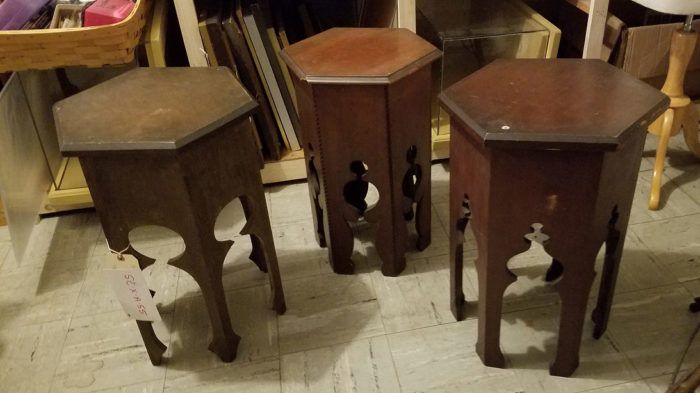Moorish design
Bob Miller looks to Andalusia for inspiration when designing a set of three tables.
My first experience traveling far from home was an educational trip to the south of Spain. This trip exposed me for the first time to a rich and varied culture that far predates that of my home. This exposure would have a profound impact on me and eventually my woodworking, the effects of which would not become fully known for years.
On this journey I was able to visit some of the great architectural wonders of Al-Andalus, the region of southern Spain now known as Andalusia.
This portion of medieval history and art is often overlooked in the American educational system and as a result not many people know of the Al-Andalus or the Córdoba Caliphate and Umayyad dynasty that created it, giving rise to one of the great civilizations of the western world. Al-Andalus was ruled by a series of Muslim dynasties from 711 to 1492, collectively referred to as “The Moors” despite being a culturally and ethnically varied group.
I was certainly one of these people who did not know how spectacular the art and history of Moorish Spain was.

Two of the places that had the most impact on me were the Mezquita, in Córdoba, a sprawling Mosque complex dating back to the year 784, with its forest of columns supporting a constellation of keyhole arches in its hypostyle hall.
 The other was the Alhambra. Rebuilt from a small fort in the hills above Grenada in the 1250s and converted into a palatial royal residence in 1333, the Alhambra became the ruling seat of the Moorish emirs in the latest centuries of Moorish rule in Al-Andalus.
The other was the Alhambra. Rebuilt from a small fort in the hills above Grenada in the 1250s and converted into a palatial royal residence in 1333, the Alhambra became the ruling seat of the Moorish emirs in the latest centuries of Moorish rule in Al-Andalus.
Moorish art and design, like many forms of Islamic and Muslim design, is characterized by intricate geometric patterns along with abstract floral and vegetal motifs. Moorish art and design is also largely aniconistic, a traditional belief in many Arab and Muslim artistic cultures which gives many forms of Islamic art its distinctively geometric and abstracted form.
After the fall of Moorish Spain in 1492, Moorish design was largely forgotten in Euro-American culture. In the late 19th century during the Arts and Crafts period, there was a brief fascination with it, because it was seen as mysterious and alluring. But Moorish design was always somewhat familiar to the west, because the Moorish culture had been in contact with western European art for nearly a millennia.
My underlying attraction to this style of design came fully to the surface 2017 when I was asked to participate in a museum exhibition with the Fruitlands Museum here in Massachusetts. The exhibit was intended to highlight the history of furniture in Massachusetts. A group of North Bennet Street School alumni were asked to select a piece of furniture from the museum’s collection and build a re-interpretation of the piece to be shown alongside the original.
As as I entered the collection space where we would find the pieces we were to use as our inspiration, I was drawn to a set of small hexagonal tables of a distinctively Moorish style. These tables came from the collection of the Stevens-Coolidge home in North Andover, Mass., the summer home of Helen Stevens Coolidge and her husband, John Gardner Coolidge. John Coolidge was a career diplomat in the early 20th century. Their home is filled with a fascinating array of furniture and artifacts from the places they lived all over the world.
 |
 |
These three tables are stylistically very similar and possibly came from the same maker, however I do not think that they were intended to be a set. All three are from around 1910, made of walnut and cherry, definitely in the Arts and Crafts tradition, and heavily influenced by the Moorish revival fashion that was popular at the time.

I decided to reinterpret this grouping of tables as a completed set of three. Nested, they form a deep cluster of arches echoing the hypostyle hall of the Mezquita, in Córdoba. They can also stack one atop the other forming a towering structure evocative of the Minarets ever present in the architecture of Mosques throughout Al-Andalus. They also form a cascade when placed alongside each other, a structure similar to the arcaded madrassas surrounding the Mezquita.
The smallest table has a gold interior to evoke the elaborate, often gilded, interiors common in Moorish architecture. The middle table is beaded along its corners to delineate and define the form, and the largest has an inset frieze surrounding the keyhole arch in which I textured and stippled the surface, then applied a turquoise glaze to evoke the mosaic found in many facades in Moorish architecture, specifically the doorways leading into the Mezquita, in Córdoba, as well as many of the friezes surrounding keyhole arches throughout the Alhambra.

I really enjoyed this collaboration as it allowed me to flex my often under-exercised history and research muscles, digging deep into the stacks of my favorite library for source material and working to understand the inner workings of Moorish art and architecture.
I continue to challenge you to think beyond the western Euro-American world and look to the traditions of other cultures for inspiration. Remember, Euro-America does not hold a monopoly on style, culture, or tradition. There is beauty and knowledge in every corner of the world, a rich and long history of art woodworking and architecture out there waiting to be explored.
Fruitlands Museum
http://fruitlands.thetrustees.org/
http://fruitlands.thetrustees.org/exhibitions
Stevens-Coolidge Place
http://www.thetrustees.org/places-to-vi … place.html
Fine Woodworking Recommended Products

Drafting Tools

Compass

Dividers





















Log in or create an account to post a comment.
Sign up Log in